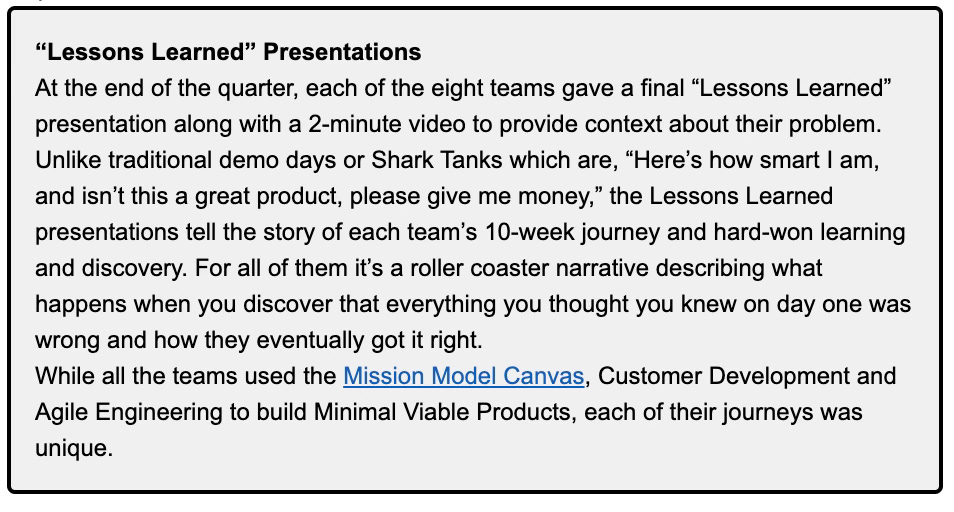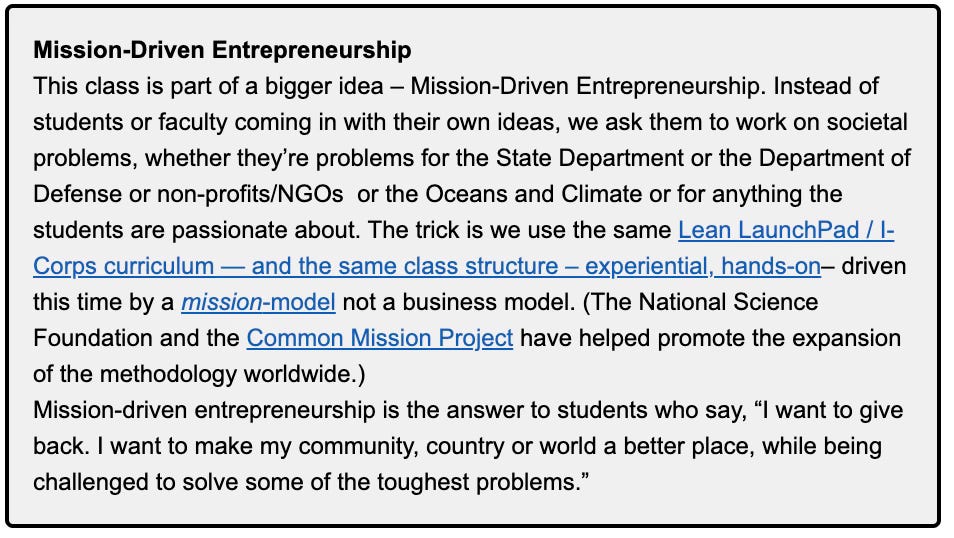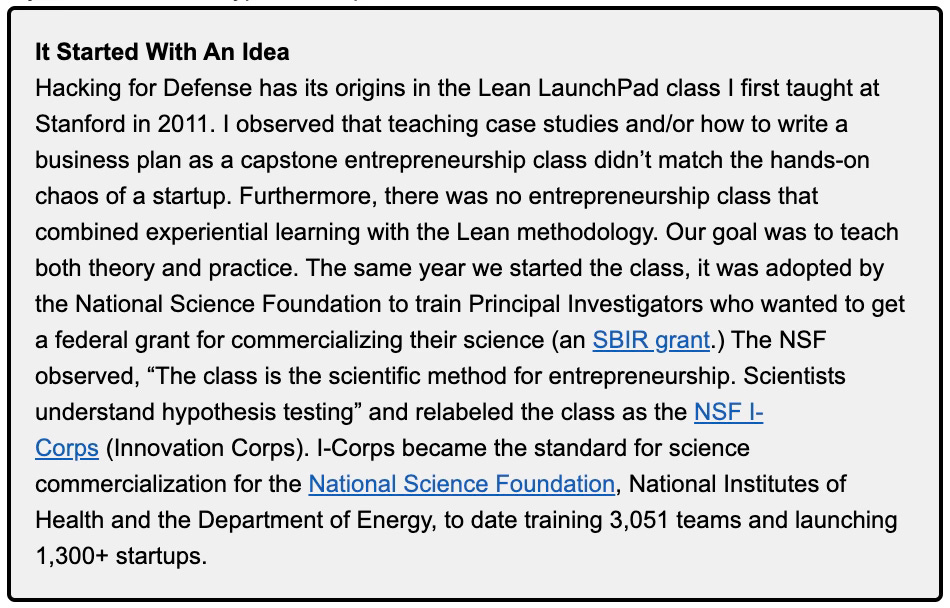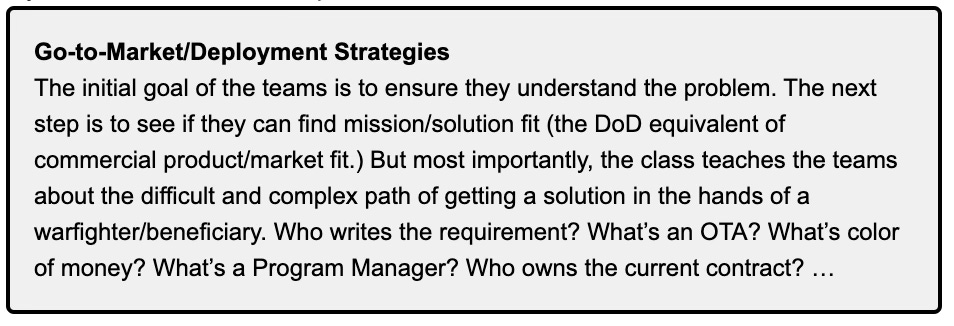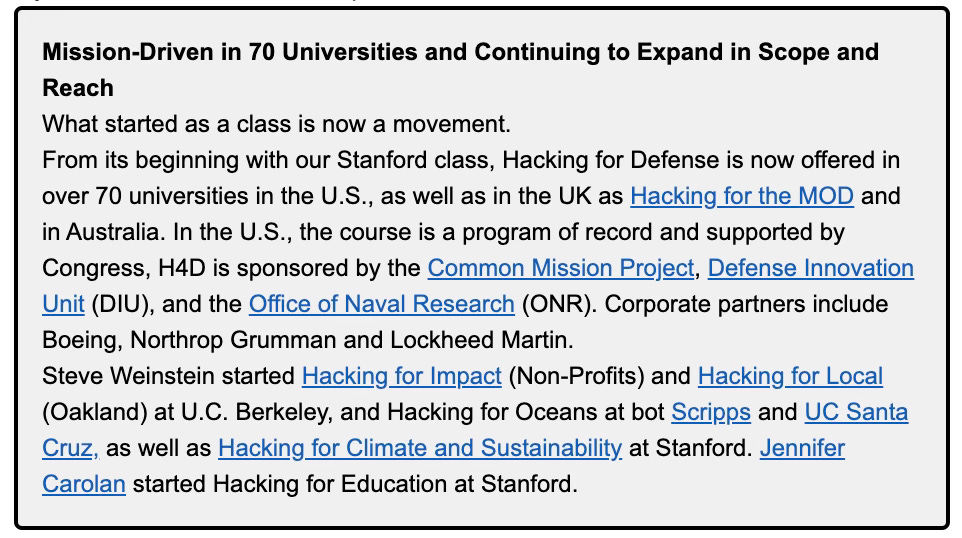Hacking for Defense @ Stanford 2025 -- Lessons Learned Presentations
The videos and PowerPoints embedded in this post are best viewed on steveblank.com
We just finished our 10th annual Hacking for Defense class at Stanford.
What a year.
Hacking for Defense, now in 70 universities, has teams of students working to understand and help solve national security problems. At Stanford this quarter the 8 teams of 41 students collectively interviewed 1106 beneficiaries, stakeholders, requirements writers, program managers, industry partners, etc. – while simultaneously building a series of minimal viable products and developing a path to deployment.
This year’s problems came from the U.S. Army, U.S. Navy, CENTCOM, Space Force/Defense Innovation Unit, the FBI, IQT, and the National Geospatial-Intelligence Agency.
We opened this year’s final presentations session with inspiring remarks by Joe Lonsdale on the state of defense technology innovation and a call to action for our students. During the quarter guest speakers in the class included former National Security advisor H.R. McMaster, Jim Mattis ex Secretary of Defense, John Cogbill Deputy Commander 18th Airborne Corps, Michael Sulmeyer former Assistant Secretary of Defense for Cyber Policy, and John Gallagher Managing Director of Cerberus Capital.
This year we had the teams add two new slides at the end of their presentation: 1) tell us which AI tools they used, and 2) their estimate of progress on the Technology Readiness Level and Investment Readiness Level.
Here’s how they did it and what they delivered.
Team Omnyra – improving visibility into AI-generated bioengineering threats.
To see the team Omnyra summary video, click here.
To see the Omnyra presentation, click here.
Team HydraStrike – bringing swarm technology to the maritime domain.
To see the HydraStrike summary video, click here.
To see the HydraStrike presentation, click here
Team HyperWatch – tracking hypersonic threats.
To see the HyperWatch video, click here.
To see the HyperWatch presentation, click here.
Team ChipForce – Securing U.S. dominance in critical minerals.
To see the ChipForce video, click here.
To see the ChipForce presentation, click here.
Note: After briefing the Department of Commerce, the Chipforce was offered jobs with the department.
Team ArgusNet – instant geospatial data for search and rescue.
To see the ArgusNet video, click here.
To see the ArgusNet presentation, click here.
Team NeoLens – AI-powered troubleshooting for military mechanics.
To see the NeoLens video, click here.
To see the NeoLens presentation, click here.
Team Omnicomm – improving the quality, security and resiliency of communications for special operations units.
To see the Omnicomm video, click here.
To see the Omnicomm presentation, click here.
Team Strom – simplified mineral value chain.
To see the Strom video, click here.
To see the Strom presentation, click here.
See the teams present in person here
It Takes A Village
While I authored this blog post, this class is a team project. The secret sauce of the success of Hacking for Defense at Stanford is the extraordinary group of dedicated volunteers supporting our students in so many critical ways.
The teaching team consisted of myself and:
Pete Newell, retired Army Colonel and ex Director of the Army’s Rapid Equipping Force, now CEO of BMNT.
Joe Felter, retired Army Special Forces Colonel; and former deputy assistant secretary of defense for South Asia, Southeast Asia, and Oceania; and currently the Director of the Gordian Knot Center for National Security Innovation at Stanford which we co-founded in 2021.
Steve Weinstein, partner at America’s Frontier Fund, 30-year veteran of Silicon Valley technology companies and Hollywood media companies. Steve was CEO of MovieLabs, the joint R&D lab of all the major motion picture studios.
Chris Moran, Executive Director and General Manager of Lockheed Martin Ventures; the venture capital investment arm of Lockheed Martin.
Jeff Decker, a Stanford researcher focusing on dual-use research. Jeff served in the U.S. Army as a special operations light infantry squad leader in Iraq and Afghanistan.
Our teaching assistants this year were Joel Johnson, Rachel Wu, Evan Twarog, Faith Zehfuss, and Ethan Hellman.
31 Sponsors, Business and National Security Mentors
The teams were assisted by the originators of their problems – the sponsors.
Sponsors gave us their toughest national security problems: Josh Pavluk, Kari Montoya, Nelson Layfield, Mark Breier, Jason Horton, Stephen J. Plunkett, Chris O’Connor, David Grande, Daniel Owins, Nathaniel Huston, Joy Shanaberger, and David Ryan.
National Security Mentors helped students who came into the class with no knowledge of the Department of Defense, and the FBI understand the complexity, intricacies and nuances of those organizations: Katie Tobin, Doug Seich, Salvadore Badillo-Rios, Marco Romani, Matt Croce, Donnie Hasseltine, Mark McVay, David Vernal, Brad Boyd, Marquay Edmonson.
Business Mentors helped the teams understand if their solutions could be a commercially successful business: Diane Schrader, Marc Clapper, Laura Clapper, Eric Byler, Adam Walters, Jeremey Schoos, Craig Seidel, Rich “Astro” Lawson.
Thanks to all!


